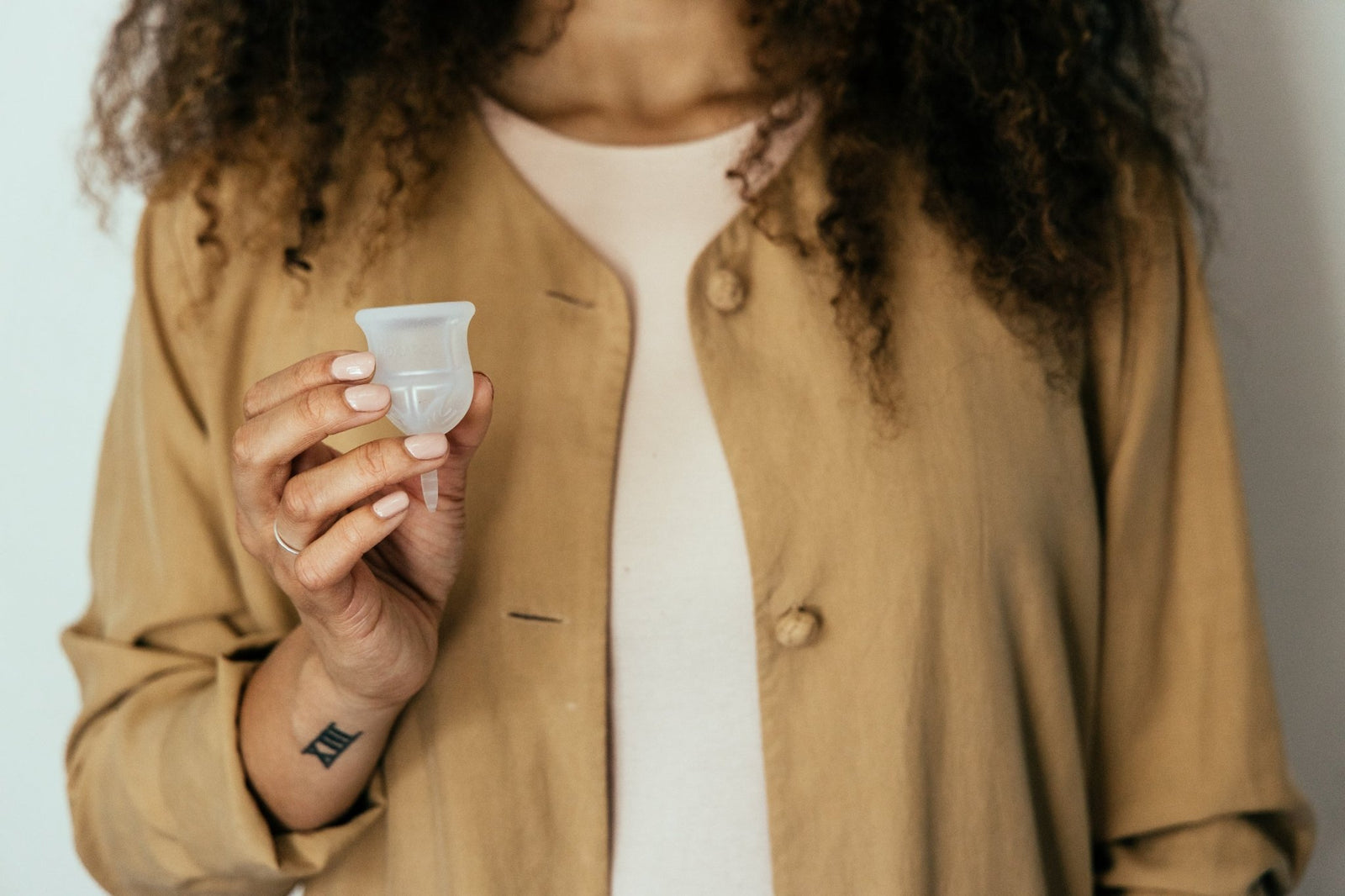
Your cervix plays an important role in your reproductive health, yet it may feel like a bit of an enigma if you don’t know what you’re looking for. We’ll break it down, starting with the basics of what your cervix is and how to find it.
Educating yourself on how your cervical position changes throughout your menstrual cycle, will let you know when you’re the most fertile so you can better manage your reproductive health. We’ll even cover how your cervix can be a point of intense sexual pleasure, and how to determine what size menstrual cup you need based on whether you have a low, medium or high cervix placement.
What is the cervix?
Your cervix is the lowest part of the uterus—a tiny passageway that connects your vagina to your uterine cavity and is about 4 cm long, with a projection of between 2.5 to 3.8 cm long into the upper vaginal cavity. When seen from the vagina, it appears as a smooth, fleshy “O” shaped structure that has a diameter ofabout 1 inch, with the inside being hollow. It resembles puckered lips in appearance but can vary in firmness at each stage of your menstrual cycle.
The cervix is responsible for several important functions:
-
It lets the sperm in and your menstrual blood out by opening and closing.
-
It contributes to the maintenance of your reproductive health by keeping viruses and bacteria out of your uterus.
-
It produces lubrication for itself, and this fluid, along with other secretions from the Bartholin glands, keeps the vagina lubricated. The fluid secretion is increased when you are aroused so that friction is reduced during sexual intercourse.
-
With pregnancy, the cervix grows a mucus plug, which is a combination of thick fluid and mucus. The purpose of this is to block the opening of the cervix so that bacteria cannot enter the uterus and the fetus is protected.
-
And, last but not least, it helps you enjoy sex. Similar to your clitoris and vagina, it also has nerve pathways that are involved in your sexual response.

How to find your cervix?
If you’ve never felt or located your cervix, it can take some practice in the beginning. We will walk you through the how-to’s and what to be looking for when you do find your cervix.

The easiest way to locate your cervix, is by using your finger, so we recommend you do this in the privacy of your own home. If you’re on your period, to avoid a bloody mess, you can locate your cervix position while in the shower.
-
Choose a time when your cervix is most likely to be positioned lower so that it’s easy to reach. Right before or after your period is usually the best time. If you currently have any sort of infection, wait to check your cervical height once it has been treated or heals.
-
Make sure your nails are trimmed and filed. Wash your hands and under your fingernails well with warm water and a natural soap before you begin.
-
Lift one of your legs onto the side of a tub or toilet seat. You can remain standing or be in a slightly squatted position.
-
Position your hand in a way that your palm faces upward. Now carefully insert your longest finger into your vaginal opening. You may prefer to use a lubrication to help with this step.
-
Feel along the vaginal wall for a round-shaped, raised circle that has a dimple in its center. This is your cervix, and you will most likely find it at the top of the front vaginal wall—nearer to the belly button as opposed to your back.
If you want to understand how your cervical position adjusts over time, try to check your cervix in the same position and at the same time of day to see how it changes throughout your cycle. Avoid checking your cervical height during or after sex, as sexual arousal impacts the positioning of your cervix and may not give you accurate or consistent information.
How does the cervix (cervical position) change throughout the menstrual cycle?
The position of your cervix in your vaginal canal changes in height and how it feels to touch at different stages of your menstrual cycle. These changes happen in the cervix due to the hormonal fluctuations that are needed to support the ovulation process and menstrual cycle.
Before Ovulation:
Once your period flow stops, the cervix will remain firm, in a lower position with the cervical opening tightly closed. You may notice that your vagina is more dry with little to no mucus or discharge during this phase (day 6-9). As you get closer to ovulation (day 10-12), however, the cervix will become more soft and moist, and begin moving towards the top of the vaginal cavity. The cervical mucus will at first be more thick and sticky, while becoming gradually less thick and more white in appearance.
During Ovulation:
Ligaments in your pelvis may shorten during ovulation, pulling the cervix to the top of the vagina, often making it difficult or impossible to reach with your finger. The cervix will open slightly and feel softer like an earlobe or lips, rather than a firm nose.
During ovulation (day 13-15), the cervix may change in its texture, becoming very soft and maybe even blending into the vaginal wall. The consistency of the cervical fluid will become very thin, stretchy, clear and slippering—much like egg whites. This allows the uterine ostium (uterine os) to fully open and aid sperm to enter. It is known as the SHOW (soft, high, open and wet) phase. Acronym aside, we can think of a few other reasons why it might be called SHOW! We’ll get to that part shortly. This is when you are most fertile, and the best time to have sex if pregnancy is the goal.
After Ovulation:
The cervix will drop lower in the vaginal canal after ovulation (day 16-28) and will become more firm, like the tip of your nose. The opening to the uterus will begin to tightly close, which happens over several hours to several days. Your cervical mucus will become thick and sticky again, and then more dry until your period starts.
If pregnancy occurs, the cervix will remain high and become soft, but the uterine ostium will still tightly close at this point. If pregnancy does not occur, the cervix will begin to drop in preparation for menstruation.
During period:
During menstrual bleeding (day 1-5), the cervix is normally low and hard and slightly open to allow the blood to flow out. It feels like the tip of your nose. You may also notice that the cervix can slightly angle to one side during menstruation.
If you use a menstrual cup, you may notice that your cervix drops mid-period impacting the best positioning of your menstrual cup in your vaginal canal. You may even find using a different fold for insertion on different days of your period makes positioning your menstrual cup into a ‘sweet spot’ that much easier.
Can your cervix bring sexual pleasure?
The cervix can have a significant impact on your sexual experience. As your cervical height changes during your cycle, you may notice that different sexual positions feel more or less pleasurable depending on where your cervix is located during your cycle.

The clitoris and vagina are well-known target zones for sexual pleasure. However, the cervix can also produce intense orgasms. This is known as ‘cervical penetration’, which can be misleading as the cervix cannot actually be penetrated. In fact, the cervical ostium is too small to be sexually penetrated, except during childbirth—at which time, sex may be the furthest thing from your mind!
The stimulation that occurs from a penis, finger (if it can be reached) or sex toy rubbing or pushing against the cervix can cause a strong pleasure sensation and full-body orgasm for some. So much so, that this orgasmic sensation inspired the nickname “cervical kiss”.
That being said, it isn’t a magic point for everyone—some people find this type of stimulation unerotic or even painful. Because the cervix has very few nerve endings, any discomfort would feel more like cramping or pressure. In addition, touching the cervix can release several emotions for some, and it should be approached with mutual consent and exploration.
What size menstrual cup do you need based on your cervical height?
Aside from the movement of your cervix throughout your menstrual cycle, your cervix also has a general placement inside the vagina. You may have had your gynecologist or doctor tell you that you have a ‘high’ or ‘low’ cervix. If not, use the following guideline to figure out your cervix height and what size menstrual cup would be the best fit for your body:
Low Cervix: You can feel your cervix with your finger inserted less than halfway.
Medium Cervix: You can feel your cervix with your finger inserted to the middle knuckle.
High Cervix: You can feel your cervix with your finger inserted beyond the middle knuckle or cannot reach your cervix at all.

When VOXAPOD menstrual cup is inserted correctly, it should not cause discomfort. If the cup is inserted too deep into the vaginal canal and positioned in contact with the cervix, it can cause discomfort or cramping. To be effective and for the most comfort, your VOXAPOD should be positioned beneath the cervix.
A small menstrual cup is recommended for users that have a low to medium cervix, while a medium menstrual cup is recommended for a medium to high cervix. You may also want to consider how heavy your period flow is and general physique when selecting a size. You can see our full sizing guide here.




Camille Maquez
June 06, 2025
Nice piece, I enjoy reading articles from this page. The current review that I saw on this page really helped me when I was going through difficult times in my marriage due to my husband’s infidelity. Thanks to the hacking assistance I got from this Spy-lord at ‘hackspeed24@gmail.com, the software genius helped hack and gained me remote access into my cheating husband’s social networks, iCloud and much viber chats, Facebook messages and yahoo messengers, calls log and spy call recording, monitoring SMS text messages remotely, improve debt on credit cards cell phone GPS location tracking, spy on WhatsApp messages Gmail and kik… I got to know that he was actually cheating on me. You can reach out to this tech genius via ‘hackspeed24@gmail.com, with everything he’s trustworthy’ he can also help you recover lost Bitcoin from fraudulent investment platforms tell him i referred you.